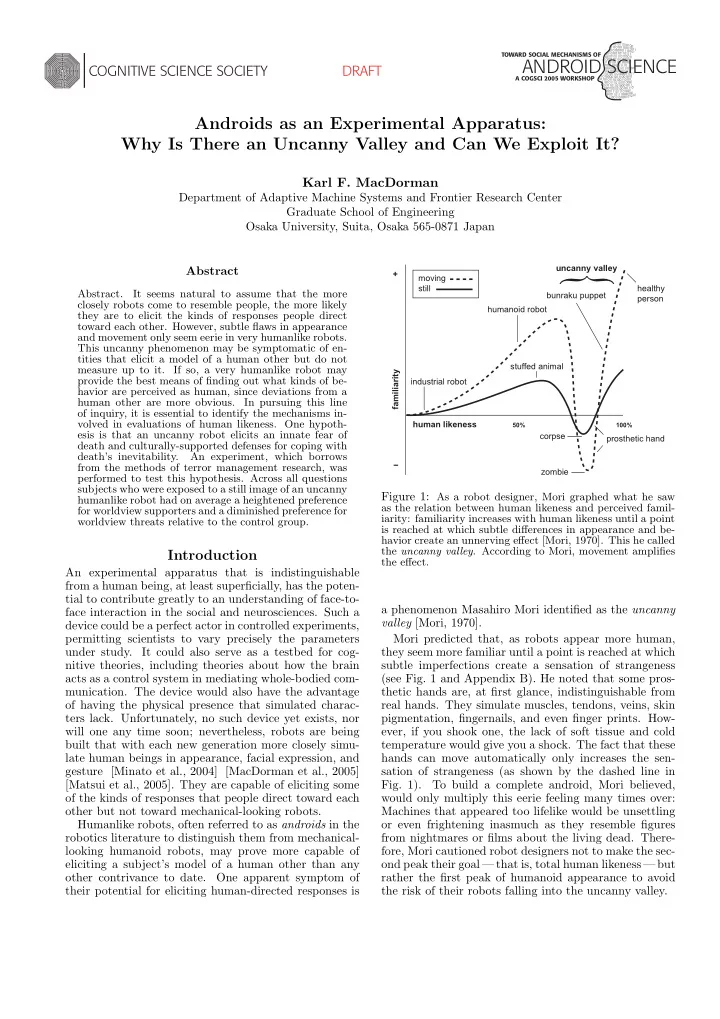

�������������� ���������������������������� ������������������������ ������������������� Androids as an Experimental Apparatus: Why Is There an Uncanny Valley and Can We Exploit It? Karl F. MacDorman Department of Adaptive Machine Systems and Frontier Research Center Graduate School of Engineering Osaka University, Suita, Osaka 565-0871 Japan uncanny valley Abstract familiarity + { moving still healthy Abstract. It seems natural to assume that the more bunraku puppet person closely robots come to resemble people, the more likely humanoid robot they are to elicit the kinds of responses people direct toward each other. However, subtle flaws in appearance and movement only seem eerie in very humanlike robots. This uncanny phenomenon may be symptomatic of en- tities that elicit a model of a human other but do not stuffed animal measure up to it. If so, a very humanlike robot may provide the best means of finding out what kinds of be- industrial robot havior are perceived as human, since deviations from a human other are more obvious. In pursuing this line of inquiry, it is essential to identify the mechanisms in- volved in evaluations of human likeness. One hypoth- human likeness 50% 100% esis is that an uncanny robot elicits an innate fear of corpse prosthetic hand death and culturally-supported defenses for coping with death’s inevitability. An experiment, which borrows from the methods of terror management research, was zombie performed to test this hypothesis. Across all questions subjects who were exposed to a still image of an uncanny Figure 1: As a robot designer, Mori graphed what he saw humanlike robot had on average a heightened preference as the relation between human likeness and perceived famil- for worldview supporters and a diminished preference for iarity: familiarity increases with human likeness until a point worldview threats relative to the control group. is reached at which subtle differences in appearance and be- havior create an unnerving effect [Mori, 1970]. This he called the uncanny valley . According to Mori, movement amplifies Introduction the effect. An experimental apparatus that is indistinguishable from a human being, at least superficially, has the poten- tial to contribute greatly to an understanding of face-to- a phenomenon Masahiro Mori identified as the uncanny face interaction in the social and neurosciences. Such a valley [Mori, 1970]. device could be a perfect actor in controlled experiments, permitting scientists to vary precisely the parameters Mori predicted that, as robots appear more human, under study. It could also serve as a testbed for cog- they seem more familiar until a point is reached at which nitive theories, including theories about how the brain subtle imperfections create a sensation of strangeness acts as a control system in mediating whole-bodied com- (see Fig. 1 and Appendix B). He noted that some pros- munication. The device would also have the advantage thetic hands are, at first glance, indistinguishable from of having the physical presence that simulated charac- real hands. They simulate muscles, tendons, veins, skin ters lack. Unfortunately, no such device yet exists, nor pigmentation, fingernails, and even finger prints. How- will one any time soon; nevertheless, robots are being ever, if you shook one, the lack of soft tissue and cold built that with each new generation more closely simu- temperature would give you a shock. The fact that these late human beings in appearance, facial expression, and hands can move automatically only increases the sen- gesture [Minato et al., 2004] [MacDorman et al., 2005] sation of strangeness (as shown by the dashed line in [Matsui et al., 2005]. They are capable of eliciting some Fig. 1). To build a complete android, Mori believed, of the kinds of responses that people direct toward each would only multiply this eerie feeling many times over: other but not toward mechanical-looking robots. Machines that appeared too lifelike would be unsettling Humanlike robots, often referred to as androids in the or even frightening inasmuch as they resemble figures robotics literature to distinguish them from mechanical- from nightmares or films about the living dead. There- looking humanoid robots, may prove more capable of fore, Mori cautioned robot designers not to make the sec- eliciting a subject’s model of a human other than any ond peak their goal — that is, total human likeness — but other contrivance to date. One apparent symptom of rather the first peak of humanoid appearance to avoid their potential for eliciting human-directed responses is the risk of their robots falling into the uncanny valley.
Recommend
More recommend